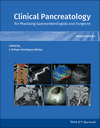Surgical Treatment of Resectable Pancreatic Cancer
What is the Optimal Strategy?
Summary
Surgical resection remains the only potentially curative treatment option for pancreatic ductal adenocarcinoma (PDAC), which is expected to become the second leading cause of cancer-associated deaths in Europe in 2030. This chapter gives an overview on the surgical management and optimal treatment strategy of resectable PDAC. Primary surgical resection followed by adjuvant chemotherapy is the standard of care for resectable pancreatic cancer, which nevertheless only accounts for about 20–25% of all patients at the time of diagnosis. In high-volume centers, pancreatic resections, especially pancreatic left resections, are nowadays increasingly performed using minimally invasive laparoscopic or robotic techniques. Patients with locally advanced pancreatic cancer are treated with extended resections in pancreatic high-volume centers to increase the resectability rate and consequently the chance for prolonged survival.



